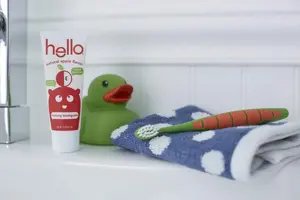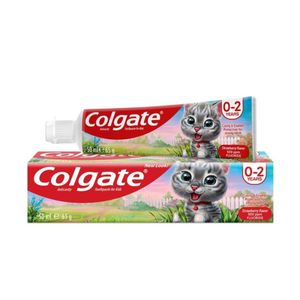From Goo-Goo to Glisten: The Training Toothpaste Breakdown
This article provides comprehensive insights into training toothpaste, a crucial tool in early oral hygiene for infants and toddlers. It highlights its fluoride-free, safe-to-swallow formulation and its role in instilling positive dental habits. Practical guidelines on when and how to introduce training toothpaste, along with tips for selection, make this a valuable read for parents seeking to promote healthy teeth and gums in their little ones.
Key Points about Training Toothpaste.

As parents, ensuring the health and well-being of our little ones is a top priority. When it comes to oral hygiene, introducing proper dental care habits early on is crucial. One of the first steps in this journey is choosing the right toothpaste for your child. Training toothpaste, also known as infant toothpaste, plays a pivotal role in laying the foundation for a lifetime of healthy teeth and gums.
What is Training Toothpaste?
Training toothpaste is specially formulated toothpaste designed for infants and toddlers. Unlike regular toothpaste, it is specifically tailored for the needs of young children who are just starting their dental care routine. Training toothpaste is fluoride-free and safe to swallow, making it ideal for little ones who may not yet have mastered the art of spitting out toothpaste.

Importance of Training Toothpaste
- Fluoride-Free Formulation: Training toothpaste is fluoride-free, which is crucial for young children who are still learning to brush their teeth. Swallowing fluoride toothpaste in large quantities can lead to fluorosis, a cosmetic issue that affects tooth enamel. With training toothpaste, you don't have to worry about this potential risk.
- Safe to Swallow: Since infants and toddlers are still learning to spit, it's important to use a toothpaste that is safe to swallow. Training toothpaste is designed with this in mind, providing an extra layer of safety.
- Introducing Proper Dental Hygiene Habits: Using training toothpaste sets the stage for good dental habits from an early age. It helps familiarize children with the brushing process and makes it a positive and enjoyable experience.
- Gentle on Sensitive Gums: The formulation of training toothpaste is gentle on the sensitive gums of young children. It helps keep their mouths clean and free from harmful bacteria, reducing the risk of gum issues.
When and How to Start Using Training Toothpaste
The American Academy of Pediatrics recommends starting to brush a child's teeth as soon as the first tooth emerges. Initially, you can use a soft, infant-sized toothbrush with just water to clean the teeth and gums. Once your child is around 2 years old and has mastered spitting, you can introduce training toothpaste.
Here's a step-by-step guide on how to use training toothpaste:
- Use a Pea-Sized Amount: Squeeze a small, pea-sized amount of training toothpaste onto the toothbrush.
- Supervise Brushing: Always supervise your child while they are brushing their teeth. This ensures they use the right amount of toothpaste and brush correctly.
- Teach Proper Technique: Show your child how to brush in gentle, circular motions, ensuring they reach all surfaces of their teeth and gums.
- Make it Fun: Encourage your child to make brushing a fun and enjoyable activity. You can play their favorite song or use a timer to make sure they brush for the recommended two minutes.
- Rinse or Spit (if possible): Encourage your child to spit out the toothpaste after brushing. If they're not yet able to spit, that's okay. The training toothpaste is safe to swallow.
Choosing the Right Training Toothpaste
When selecting a training toothpaste, consider the following factors:
- Flavor: Choose a flavor that your child enjoys. Popular options include fruit flavors like strawberry or banana.
- Age Recommendation: Different training toothpaste products may have specific age recommendations. Make sure to choose one that is appropriate for your child's age.
- Check Ingredients: Look for training toothpaste that is free from artificial colors, preservatives, and other potentially harmful additives.
- Consult with a Pediatric Dentist: If you have specific concerns or your child has special dental needs, consult with a pediatric dentist for personalized recommendations.
Best Sellers in Baby Training Toothpaste Along with a Brief Overview
Orajel:
- Overview: Orajel training Toothpaste is a trusted oral care product specifically designed for young children. This toothpaste is formulated with a focus on safety and effectiveness, making it an excellent choice for toddlers and infants who are beginning their dental hygiene routines. It is fluoride-free, addressing the concern of accidental ingestion common in younger children.
Colgate:
- Overview: Colgate is a globally recognized oral care brand that offers a wide range of dental hygiene products, including toothpaste for children. They have training toothpaste specifically designed for infants and toddlers, often with fun flavors to encourage brushing.
Tom's of Maine:
- Overview: Tom's of Maine is known for producing natural and eco-friendly personal care products. They offer a range of toothpaste products, including options for children. Their training toothpaste is fluoride-free and made from natural ingredients.
Oral-B:
- Overview: Oral-B is a prominent oral care brand that provides a variety of dental hygiene products, including toothpaste for children. They offer training toothpaste with mild flavors to make brushing an enjoyable experience for kids.
Jack N' Jill:
- Overview: Jack N' Jill is a brand focused on natural oral care products for infants, toddlers, and children. They offer a range of training toothpaste that is fluoride-free, with organic ingredients and various appealing flavors.
Weleda:
- Overview: Weleda is a company known for producing natural and holistic health and beauty products. They offer a children's toothpaste line, including training toothpaste that is free from artificial preservatives, flavors, and colorants.
Radius:
- Overview: Radius specializes in eco-friendly and innovative oral care products. They offer a children's toothpaste line, including training toothpaste, with organic ingredients and unique, kid-friendly flavors.
Hello:
- Overview: Hello is a brand that focuses on producing oral care products with naturally derived ingredients. They offer training toothpaste options that are fluoride-free, SLS-free, and come in appealing flavors for kids.
Nuby:
- Overview: Nuby is a company that provides a wide range of baby and toddler products, including oral care items. They offer training toothpaste that is safe to swallow, making it suitable for young children.

People also ask (FAQ)
Can babies swallow training toothpaste?
At what age can babies start using toothpaste?
What kind of toothpaste do you use for babies?
How can I clean my baby's teeth naturally?
Can you use toothpaste on a 3 month old?
How do you clean a newborn's tongue?
Can babies swallow training toothpaste?
- Yes, babies can swallow training toothpaste. In fact, training toothpaste is specifically formulated to be safe if ingested. It is fluoride-free and typically does not contain any harmful chemicals.
At what age can babies start using toothpaste?
- It is generally recommended to start using a small amount of training toothpaste around the age of 2, or when your child has the ability to spit out the toothpaste. Before this age, you can clean your baby's teeth and gums with a soft, damp cloth or a baby toothbrush without toothpaste.
What kind of toothpaste do you use for babies?
- For babies, it is recommended to use training toothpaste. This type of toothpaste is specifically designed for infants and toddlers. It is fluoride-free and safe to swallow, making it suitable for young children who are still learning to brush their teeth.
How can I clean my baby's teeth naturally?
- You can clean your baby's teeth naturally by using a clean, damp cloth or a soft baby toothbrush. Gently wipe or brush their teeth and gums after meals. You can also use a silicone finger brush designed for infants. Additionally, you can introduce a fluoride-free training toothpaste around the age of 2.
Can you use toothpaste on a 3-month old?
- At 3 months old, it is not necessary to use toothpaste. Instead, you can clean your baby's gums using a clean, damp cloth or a silicone finger brush designed for infants. Once your baby starts teething and their first tooth emerges, you can begin using a small amount of training toothpaste.
How do you clean a newborn's tongue?
- To clean a newborn's tongue, you can use a clean, damp cloth or a piece of gauze. Gently wrap the cloth or gauze around your index finger, then gently wipe your baby's tongue from back to front. Be very gentle to avoid causing discomfort. This can be done during your regular diaper-changing routine.
Remember, it's essential to establish good oral hygiene habits from an early age. Regularly cleaning your baby's gums and eventually their teeth can help maintain their oral health and set the foundation for a lifetime of healthy teeth and gums. Always consult with your pediatrician or dentist if you have any specific concerns or questions about your baby's oral care routine.
Training toothpaste is a vital tool in establishing good oral hygiene habits in young children. By selecting the right product and following proper brushing techniques, you can set the foundation for a lifetime of healthy teeth and gums. Remember to make the brushing experience enjoyable and supervise your child's brushing routine until they can do it independently. With these steps, you'll be well on your way to promoting excellent oral health in your little one.



